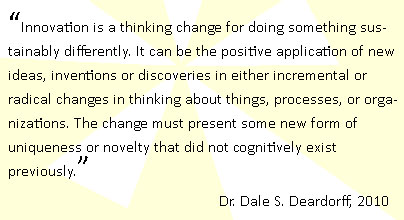


Innovation Leadership Session Description:
The Innovation Leadership RPLC Accelerated Learning Share-Module is a Team and Leader based methodology structured to introduce the key concepts of Innovation and Creativity thru a reading tutorial completed offline prior to a 4 hour facilitated intervention.
Innovation Leadership requires leading from a new mindset. Leading innovation is about getting people to think beyond the obvious and allowing people to get in the act of solving tough problems, improving quality, building customer loyalty, and taking the company's strategy to a new level.
When new innovations in products, services, and processes have been defined and validated, it takes leadership capabilities to get people to change to support new concepts and work methods. It is natural for people to be comfortable with the status quo. Since resistance to change is a natural phenomenon in all organizations, leaders have to be courageous change agents to make innovations stick.
Innovation Leadership requires:
- Vision and goal setting
- Developing your core competencies
- Motivating your people
- Nurturing new ideas
- Having described the goal to be achieved, Leaders need to go back to their own work of thinking forward, and give the organization room to deliver results.
Having described the goal to be achieved, leaders need to go back to their own work of thinking forward in a positive direction, and give the organization room to deliver against those expectations.
Leaders must be clear about what being innovative would look like in your organization, and then articulate this vision for others to see and discuss.
Do an honest assessment of the current reality in each of the areas, articulate the interconnection between becoming innovative and the business needs continuously and relentlessly at every opportunity.
- Create the Leadership paradigm mindset shift from the natural reactive to the creative. It is very easy for Leaders to become accustomed to “asking for the impossible,” this will need to be tempered by what is realistic and achievable. Leaders have to understand how they can inadvertently deter innovation and how to avoid those tendencies.
- Involve people at all levels in the innovation effort, so that they can be part of the creation.
- Leaders must clearly and consistently articulate the vision and describe what success looks like. The goals for innovation need to be articulated by Leadership so that everyone understands the need and the connection to profitability and competitiveness in the business. When these connections are not clear, individuals may appear resistant to change, when in fact they could drive innovation if they were operating from a position of knowledge.
The Leadership Culture needs:
- Goals that are understood by all.
- Risk taking which is encouraged and accepted.
- New ideas that are welcomed.
- Information exchange which is open and shared.
- Good ideas that are supported.
- Innovations are recognized and rewarded.
- People are given room to be creative.
Discuss the Culture at 3M - A conscious effort to recruit creative, independent people with specialist knowledge to support their divisions.
It is critical to have a formalized structure around innovation so people know what the process is, how to create new ideas, what to do with them and finally how to implement. Leaders are responsible for stating where you want to get to. If you engage staff in how to get there, that’s where you will get … better ideas. When leaders get too involved, then innovation stalls because they are not thinking forward.
Leaders can actually inadvertently stall innovation. In the absence of a clear business reason or articulated need for innovation, everyone can lose the focus on how to make the new ideas stick.
Those leaders who become impatient can risk shifting focus too soon and losing any gains made. The return on innovation (ROI) will only come from a
sustainable change, where project and program activities are converted into
institutionalized processes through a deliberate organizational effort.
Organizations can talk a lot about the need for innovation, but in the absence of an actual innovation strategy most of the organization may be unclear about what is expected and what is permitted.
For more information on cost and event booking, email RPLC
